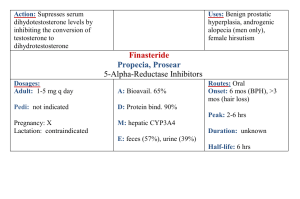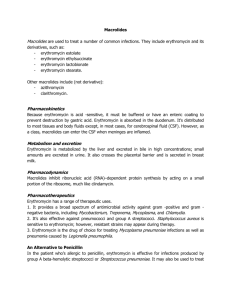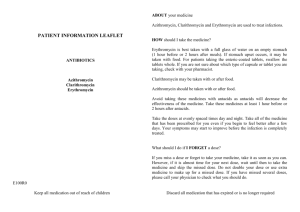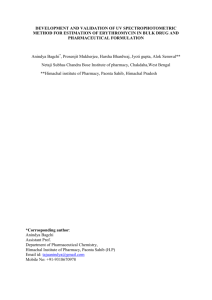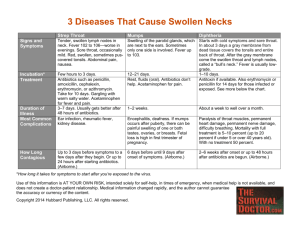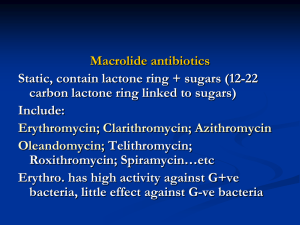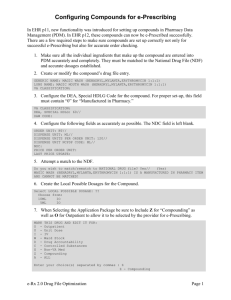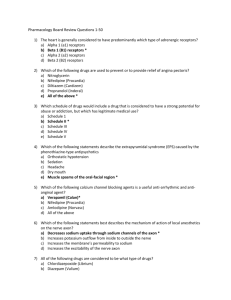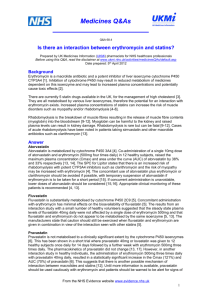Erythromycin prokinetic doses
advertisement
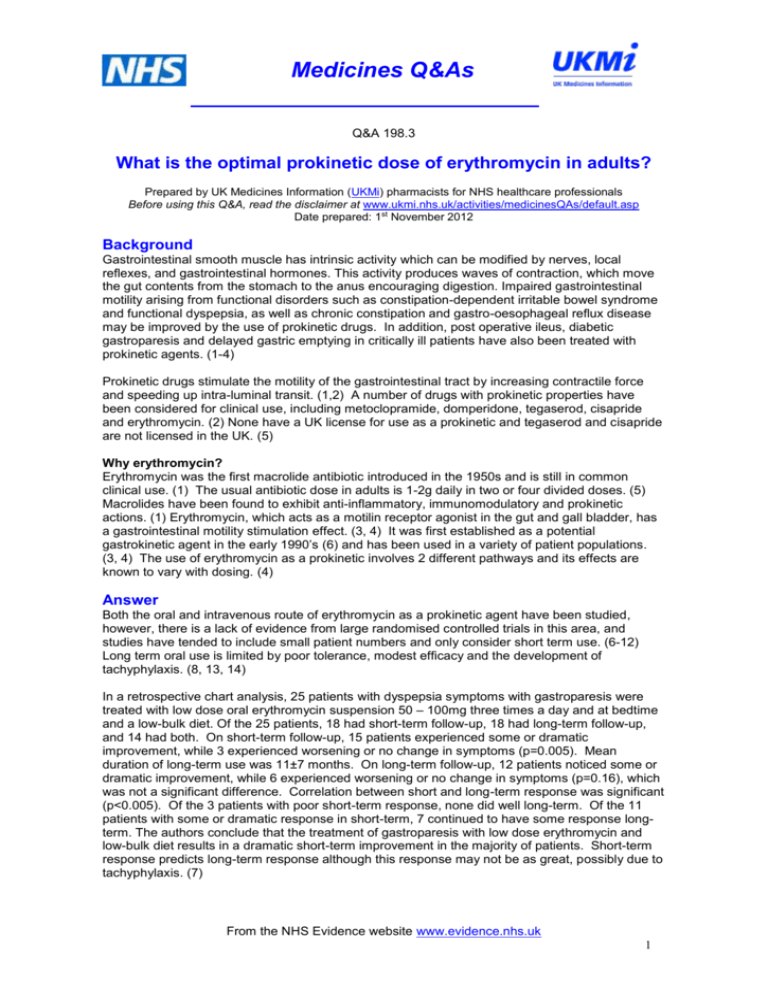
Medicines Q&As Q&A 198.3 What is the optimal prokinetic dose of erythromycin in adults? Prepared by UK Medicines Information (UKMi) pharmacists for NHS healthcare professionals Before using this Q&A, read the disclaimer at www.ukmi.nhs.uk/activities/medicinesQAs/default.asp Date prepared: 1st November 2012 Background Gastrointestinal smooth muscle has intrinsic activity which can be modified by nerves, local reflexes, and gastrointestinal hormones. This activity produces waves of contraction, which move the gut contents from the stomach to the anus encouraging digestion. Impaired gastrointestinal motility arising from functional disorders such as constipation-dependent irritable bowel syndrome and functional dyspepsia, as well as chronic constipation and gastro-oesophageal reflux disease may be improved by the use of prokinetic drugs. In addition, post operative ileus, diabetic gastroparesis and delayed gastric emptying in critically ill patients have also been treated with prokinetic agents. (1-4) Prokinetic drugs stimulate the motility of the gastrointestinal tract by increasing contractile force and speeding up intra-luminal transit. (1,2) A number of drugs with prokinetic properties have been considered for clinical use, including metoclopramide, domperidone, tegaserod, cisapride and erythromycin. (2) None have a UK license for use as a prokinetic and tegaserod and cisapride are not licensed in the UK. (5) Why erythromycin? Erythromycin was the first macrolide antibiotic introduced in the 1950s and is still in common clinical use. (1) The usual antibiotic dose in adults is 1-2g daily in two or four divided doses. (5) Macrolides have been found to exhibit anti-inflammatory, immunomodulatory and prokinetic actions. (1) Erythromycin, which acts as a motilin receptor agonist in the gut and gall bladder, has a gastrointestinal motility stimulation effect. (3, 4) It was first established as a potential gastrokinetic agent in the early 1990’s (6) and has been used in a variety of patient populations. (3, 4) The use of erythromycin as a prokinetic involves 2 different pathways and its effects are known to vary with dosing. (4) Answer Both the oral and intravenous route of erythromycin as a prokinetic agent have been studied, however, there is a lack of evidence from large randomised controlled trials in this area, and studies have tended to include small patient numbers and only consider short term use. (6-12) Long term oral use is limited by poor tolerance, modest efficacy and the development of tachyphylaxis. (8, 13, 14) In a retrospective chart analysis, 25 patients with dyspepsia symptoms with gastroparesis were treated with low dose oral erythromycin suspension 50 – 100mg three times a day and at bedtime and a low-bulk diet. Of the 25 patients, 18 had short-term follow-up, 18 had long-term follow-up, and 14 had both. On short-term follow-up, 15 patients experienced some or dramatic improvement, while 3 experienced worsening or no change in symptoms (p=0.005). Mean duration of long-term use was 11±7 months. On long-term follow-up, 12 patients noticed some or dramatic improvement, while 6 experienced worsening or no change in symptoms (p=0.16), which was not a significant difference. Correlation between short and long-term response was significant (p<0.005). Of the 3 patients with poor short-term response, none did well long-term. Of the 11 patients with some or dramatic response in short-term, 7 continued to have some response longterm. The authors conclude that the treatment of gastroparesis with low dose erythromycin and low-bulk diet results in a dramatic short-term improvement in the majority of patients. Short-term response predicts long-term response although this response may not be as great, possibly due to tachyphylaxis. (7) From the NHS Evidence website www.evidence.nhs.uk 1 DiBaise et al also conducted a retrospective chart review of 11 outpatients with gastroparesis who were treated with intravenous erythromycin administered via a peripherally inserted central venous catheter for at least one month. (8) The 11 patients received a total of 14 courses of intravenous erythromycin for a median of 6.5 months (range 1 to 19 months) at a median dosage of 300mg/day (range, 150-1000mg/day). One patient received no benefit, two had complete responses, and all the others reported some benefit. Two had dramatic relapse on cessation of therapy and subsequently improved on its resumption. Parenteral nutrition was discontinued in one of four patients. There were four episodes of line sepsis and two required catheter removal. A non-occlusive thrombus developed at the site of a central line in one patient. Secondary infections or antibiotic resistance were not encountered. The study authors concluded that the small, uncontrolled retrospective study of administration of intravenous erythromycin for prolonged periods in an outpatient setting is feasible, well tolerated and effective in patients with severe gastroparesis. (8) Early enteral nutrition is a fundamental element of critical care practice. Enteral nutrition increases gut blood flow, which protects the gastric mucosa resulting in fewer septic complications. Early feeding decreases catabolic response to injury, decreases stress ulceration in ventilated patients, improves gut immune function and improves wound healing. Successful enteral feeding relies on intact gastrointestinal motility which is frequently impaired in the critically ill. (4) In a prospective randomised controlled study, Reignier et al examined the effects of erythromycin on early enteral nutrition in mechanically ventilated critically ill patients. 40 patients were randomly assigned to receive either intravenous erythromycin 250mg four times a day or placebo for 5 days. The treated group experienced a significant decrease in residual gastric volume for the first 3 days of feeding and a significant decrease in the number of patients unable to tolerate enteral nutrition (35% vs. 70%). (9) In a study involving 35 randomly selected, mechanically ventilated, enterally fed, critically ill patients, 2 doses of intravenous erythromycin were compared for their effect on gastric emptying. Treatment with 70mg and 200mg intravenous erythromycin given over 20 minutes were shown to be equally effective in accelerating gastric emptying in these patients. (10) A prospective, randomized, controlled trial studied 68 critically ill trauma patients who had failed to tolerate gastric feeding at any time during the first 48 hours since admission. Patients were randomized to placebo or intravenous erythromycin 250mg four times daily and treatment continued in patients who tolerated gastric feeds until the feeds were no longer required. There was significant difference between the groups for the amount of feedings tolerated at 48 hours after randomization (p=0.001). However, there was no difference in the amount of feeding tolerated during the entire study period (p=0.061). The authors concluded that erythromycin was useful in the short term for delayed gastric emptying. (11) In an observational comparative study, 29 medical, feed intolerant, mechanically ventilated critically ill patients, were treated with intravenous erythromycin 200mg twice daily to improve feed tolerance. Plasma erythromycin levels were measured 1 hour and 7 hours after drug administration for 7 days. The success of enteral feeding was defined as 6 hourly gastric residual volume ≤ 250ml with a feeding rate ≥ 40ml/hour. At day 7, 38% (11 of 29) of patients were feed tolerant. Feed-intolerant patients who had lower plasma erythromycin concentrations had a longer response to therapy. The authors suggest the use of low doses of erythromycin not exceeding 200mg twice daily. Tailoring the dose of erythromycin to plasma concentrations may also be useful in reducing erythromycin tachyphylaxis. (12) Two textbooks on drug dosing in critical care patients (15, 16) give dosing suggestions for erythromycin when used as a prokinetic agent. Paw and Shulman advise a dose of 125mg four times a day orally or via a nasogastric tube or 125mg- 250mg intravenously every 6-12 hours. (15) They also suggest that the use of erythromycin as a prokinetic may increase patient colonization with resistant bacterial species including methicillin resistant staphylococcus aureus (MRSA). (15) The Oxford Handbook of Critical Care gives a dose of 250mg four times a day orally or intravenously when erythromycin is used as a gut motility agent. (16) There have been concerns that the use of low dose erythromycin may lead to the development of macrolide resistance and increase the risk of Clostridium difficile (CD) diarrhoea and nosocomial 2 From the NHS Evidence website www.evidence.nhs.uk infections. (1,17) Hawkyard and colleagues suggested further work is needed to fully assess the potential epidemiological impact of the increased use of macrolides on the spread of resistance given the lack of convincing evidence that erythromycin is a superior prokinetic agent compared with alternatives in the critical care setting. (1) However, one study in 2008 looked at 183 intensive care patients who had received low dose erythromycin prokinetic therapy and found that diarrhoea was not found to have been caused by CD or bacterial infections but may have been due to the pro-motility effects of erythromycin. (17) The use of erythromycin in trauma patients also did not increase the risk of nosocomial infections. (11) Other safety considerations such as the numerous drug interactions with erythromycin due to the inhibition of the cytochrome P450 pathway, and the prevention of cardiovascular complications such as QTc prolongation and an association with torsades de pointes, should be considered before prescribing erythromycin as a prokinetic agent. (13, 18). Summary The ideal prokinetic dose of erythromycin is yet to be established but is less than the maximal antibacterial dose of erythromycin. There is not a standard regimen for erythromycin when used as a prokinetic agent. With intravenous erythromycin, satisfactory outcomes have been achieved with doses of 300mg daily in divided doses, with 250mg four times a day, and with single doses of 70mg and 200mg. Oral erythromycin has been used effectively as a prokinetic at doses from 50mg three times daily up to 250mg four times daily. When prescribing erythromycin as a prokinetic, consideration should be given to its potential to interact with other drugs, and the possibility of cardiovascular complications. It has been suggested that the use of lower doses may be as effective as higher doses and reduce the risk of tachyphylaxis, although these concepts require further study. Limitations This Q&A has not evaluated the use of erythromycin as a prokinetic in children or the use of any other prokinetic agents. It has also not considered whether erythromycin is the most suitable prokinetic agent to use. Disclaimer Medicines Q&As are intended for healthcare professionals and reflect UK practice. Each Q&A relates only to the clinical scenario described. Q&As are believed to accurately reflect the medical literature at the time of writing. The authors of Medicines Q&As are not responsible for the content of external websites and links are made available solely to indicate their potential usefulness to users of NeLM. You must use your judgement to determine the accuracy and relevance of the information they contain. This document is intended for use by NHS healthcare professionals and cannot be used for commercial or marketing purposes. See NeLM for full disclaimer. References 1. Hawkyard CV, Koerner RJ. The use of erythromycin as a gastrointestinal prokinetic agent in adult critical care: benefits versus risks. Journal of Antimicrobial Chemotherapy 2007;59:347358. 2. Sweetman S, editor. Martindale: The Complete Drug Reference. Prokinetic drugs Accessed 31/10/12 via www.medicinescomplete.com 3. Sandham DA. Recent developments in gastrointestinal prokinetic agents. Expert Opinion on Therapeutic Patents 2008; 18(5):501-514. 4. Doherty WL, Winter B. Prokinetic agents in critical care. Critical Care 2003; 7:206-208. 5. Ryan R, editor. British National Formulary No 64. London: British Medical Association and The Royal Pharmaceutical Society of Great Britain; September 2012. Accessed on 31/10/12 via www.bnf.org/ 6. Fraser RJL, Bryant L. Current and future therapeutic prokinetic therapy to improve enteral feed intolerance in the ICU patient. Nutrition in Clinical Practice 2010; 25(1):26-31. 3 From the NHS Evidence website www.evidence.nhs.uk 7. Dhir R, Richter JE. Erythromycin in the short and long-term control of dyspepsia symptoms in patients with gastroparesis. Journal of Clinical Gastroenterology 2004; 38:237-242. 8. DiBaise JK, Quigley EMM. Efficacy of prolonged administration of intravenous erythromycin in an ambulatory setting as treatment of severe gastroparesis: one centre’s experience. Journal of Clinical Gastroenterology 1999;28(2):131-134. 9. Reignier J, Bensaid S, Perrin-Gachadoat D et al. Erythromycin and early enteral nutrition in mechanically ventilated patients. Critical Care Medicine 2002; 30(6):1237-1241. 10. Ritz MA, Chapman MJ, Fraser RJ et al. Erythromycin dose of 70mg accelerates gastric emptying as effectively as 200mg in the critically ill. Intensive Care Medicine 2005;31:949-954. 11. Berne JD, Norwood SH, McAuley CE et al. Erythromycin reduces delayed gastric emptying in critically ill trauma patients: a randomised controlled trial. The Journal of Trauma, Injury, Infection and Critical Care. 2002; 53(3):422-425. 12. Nguyen NQ, Grgurinovich N, Bryant LK et al. Plasma erythromycin concentrations predict feeding outcomes in critically ill patients with feed intolerance. Critical Care Medicine 2011; 39:868-871. 13. Chini P, Toskes PP, Waseem S, et al. Effect of azithromycin on small bowel motility in patients with gastrointestinal dysmotility. Scandinavian Journal of Gastroenterology 2012; 47:422-427. 14. Kashyap P, Farrugia G. Diabetic gastroparesis: what we have learned and had to unlearn in the past 5 years. Gut 2010; 59:1716-1726. 15. Paw H and Shulman R. Drugs in Intensive Care. An A-Z Guide. Fourth Edition, 2010. Cambridge University Press, p88-89. 16. Singer M and Webb A. Oxford Handbook of Critical Care. 2 nd Edition, 2008. Oxford University Press, p226-7. 17. Nguyen NQ, Ching K, Fraser RJ et al. Risk of Clostridium difficile diarrhoea in critically ill patients treated with erythromycin-based prokinetic therapy for feed intolerance. Intensive Care Medicine 2008; 34:169-173. 18. Berthet S, Charpiat B, Marbrut JY. Erythromycin as prokinetic agent: risk factors. Journal of Visceral Surgery 2010; 147(2):e13-18. Quality Assurance Prepared by Sarah Cavanagh, East Anglia Medicines Information Service, Ipswich Hospital Trust Date Prepared 1st November 2012 Checked by Katie Smith, East Anglia Medicines Information Service, Ipswich Hospital Trust Date of check 19th November 2012 Search strategy In-house enquiry database and standard resources, search term=erythromycin AND motility stimulants. Micromedex via www.thompsonhc.com search term Erythromycin Cochrane library search term Erythromycin Internet search BNF 64, Electronic Medicines Compendium, Martindale via Medicines complete, National Electronic Library for Medicines, NICE, Google. Medline: exp ERYTHROMYCIN/ and prokinetic.ti,ab, Limit to: English Language and Humans and Publication Year 2009-Current Embase: exp ERYTHROMYCIN/; and *PROKINETIC AGENT/, Limit to: Human and English Language and Publication Year 2009-Current 4 From the NHS Evidence website www.evidence.nhs.uk
